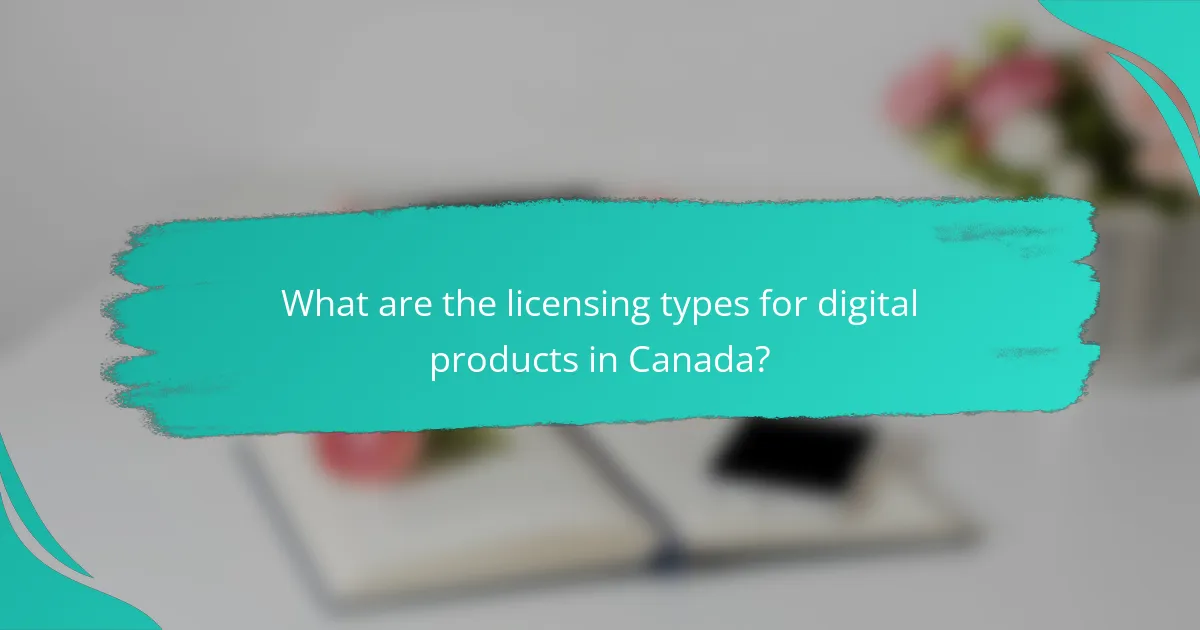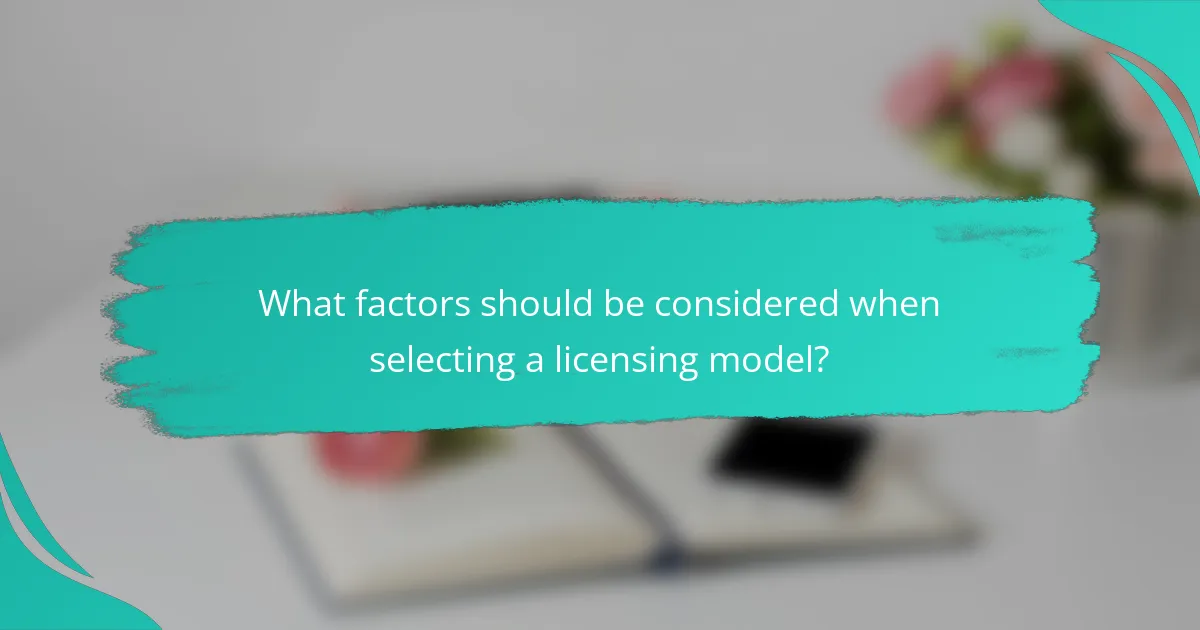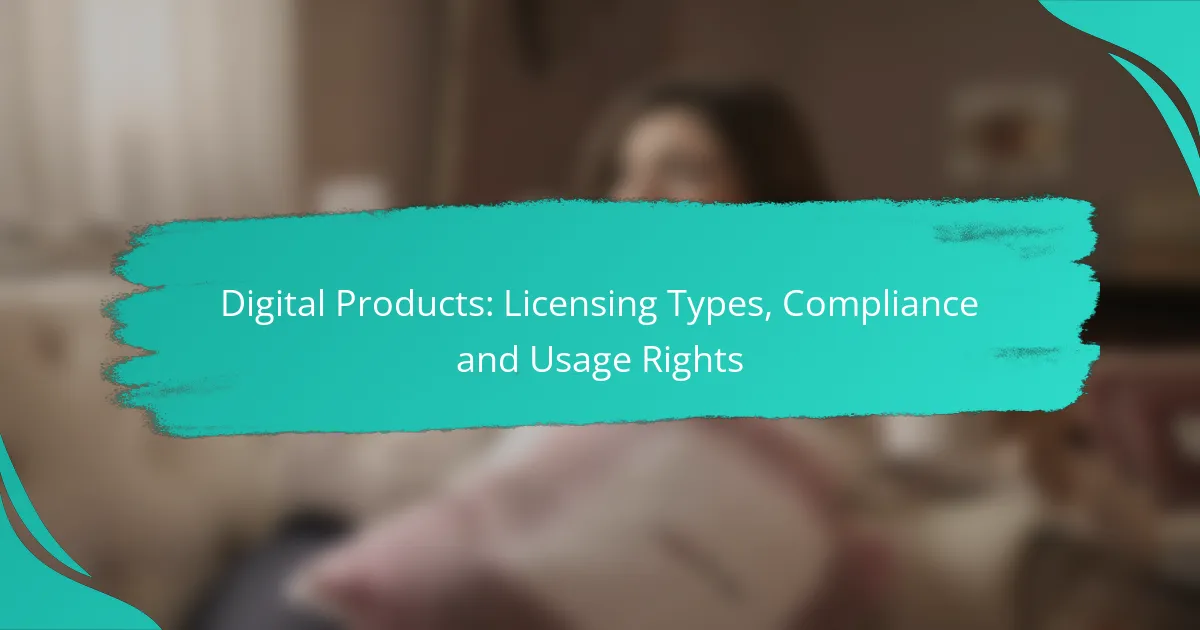Digital products in Canada are governed by various licensing types that specify how these products can be used, shared, and modified. Understanding these licenses is essential for both creators and users to ensure compliance with legal requirements and to uphold proper usage rights. Compliance not only protects against legal issues but also fosters ethical practices in the digital landscape.

What are the licensing types for digital products in Canada?
In Canada, digital products can be licensed under several types, each defining how the product can be used, shared, and modified. Understanding these licensing types is crucial for both creators and users to ensure compliance and proper usage rights.
Exclusive licenses
Exclusive licenses grant a single licensee the rights to use a digital product, effectively excluding all others, including the original creator. This type of license is often used in high-value transactions, where the licensee pays a premium for the exclusivity.
When negotiating an exclusive license, it’s essential to clearly outline the scope of use, duration, and any geographical restrictions. For instance, a software company might grant an exclusive license for a specific region, ensuring that no other entity can use that software in that area.
Non-exclusive licenses
Non-exclusive licenses allow multiple users to access and use the same digital product simultaneously. This is common in scenarios such as music licensing or software subscriptions, where many users can benefit from the same product without restrictions.
While non-exclusive licenses are generally more affordable than exclusive ones, they may come with limitations on usage. For example, a non-exclusive software license might restrict the number of installations or require additional fees for commercial use.
Creative Commons licenses
Creative Commons licenses provide a flexible range of protections and freedoms for authors and users of digital products. These licenses allow creators to specify how others can use their work, including options for attribution, non-commercial use, and modifications.
In Canada, the most common Creative Commons licenses include Attribution (CC BY), which allows others to use the work as long as they credit the creator, and Attribution-NonCommercial (CC BY-NC), which restricts use to non-commercial purposes. Understanding these options helps users comply with the terms while promoting creative sharing.
Open source licenses
Open source licenses permit users to access, modify, and distribute software freely. These licenses are vital in the software development community, encouraging collaboration and innovation by allowing developers to build upon existing code.
Popular open source licenses include the MIT License and the GNU General Public License (GPL). Each has specific requirements regarding distribution and modification, so it’s important for users to review these terms to ensure compliance when using open source software.
Public domain
Public domain refers to digital products that are not owned by anyone and can be freely used by anyone for any purpose. Works enter the public domain either when their copyright expires or if the creator explicitly relinquishes their rights.
In Canada, works published before 1924 are generally in the public domain, allowing users to access and utilize them without restrictions. However, users should verify the status of a work to avoid potential copyright issues, especially with more recent materials.

How do compliance requirements affect digital product licensing?
Compliance requirements significantly influence digital product licensing by dictating how products can be used, distributed, and modified. Adhering to these regulations ensures that creators and users avoid legal pitfalls and maintain ethical standards in their operations.
Legal obligations
Legal obligations encompass the laws and regulations that govern digital products, including copyright, trademark, and licensing agreements. For instance, software licenses often require users to comply with specific terms regarding usage and redistribution. Failing to meet these obligations can lead to legal action, including fines or product recalls.
It’s essential for businesses to clearly outline their licensing terms and ensure that users understand their rights and responsibilities. This can be achieved through clear documentation and user agreements that specify the scope of use and any restrictions.
Industry standards
Industry standards refer to the best practices and guidelines established by professional organizations that govern digital products. These standards help ensure that products are safe, reliable, and compatible across different platforms. For example, the International Organization for Standardization (ISO) sets standards that many software developers follow to ensure quality and interoperability.
Adhering to these standards not only enhances product credibility but also helps in maintaining compliance with legal obligations. Companies should regularly review and update their practices to align with evolving industry standards.
Consumer protection laws
Consumer protection laws are designed to safeguard users from unfair practices and ensure that digital products meet certain quality and safety benchmarks. These laws often require transparency in licensing agreements, ensuring that consumers are fully informed about their rights and the limitations of the products they purchase.
Businesses should implement clear return policies and provide adequate customer support to comply with these laws. Regular audits of licensing practices can help identify potential areas of non-compliance and improve overall consumer trust.

What are the usage rights associated with digital products?
Usage rights for digital products define how users can legally utilize the content. These rights vary significantly based on the type of license purchased, impacting personal, commercial, and modification capabilities.
Personal use rights
Personal use rights allow individuals to use digital products solely for their own enjoyment or benefit. This typically includes activities like viewing, listening, or reading without any intention to distribute or profit from the content.
For example, purchasing an eBook for personal reading or downloading music for personal enjoyment falls under personal use rights. Users should refrain from sharing or selling the content, as this could violate the licensing agreement.
Commercial use rights
Commercial use rights enable users to utilize digital products for business purposes, including resale or incorporation into products or services. This type of license is essential for businesses looking to leverage digital content for profit.
For instance, a graphic designer may purchase stock images with commercial rights to use in client projects. It’s crucial to verify the specific terms, as some licenses may restrict the number of copies or the types of projects where the content can be used.
Modification rights
Modification rights grant users the ability to alter or adapt digital products to suit their needs. This can include editing, remixing, or creating derivative works based on the original content.
For example, a user with modification rights can take a template and customize it for their brand. However, it’s important to check the licensing terms, as some licenses may prohibit modifications or require attribution to the original creator.

What are the best practices for licensing digital products?
Best practices for licensing digital products focus on clarity, compliance, and thorough documentation. Implementing these practices helps ensure that both creators and users understand their rights and obligations, reducing the risk of legal issues.
Clear terms and conditions
Establishing clear terms and conditions is essential for licensing digital products. These terms should outline usage rights, restrictions, and any obligations for both parties. For example, specifying whether the license is exclusive or non-exclusive can prevent misunderstandings.
Ensure that the language used is straightforward and accessible, avoiding legal jargon that may confuse users. Consider including examples of acceptable and prohibited uses to further clarify expectations.
Regular audits
Conducting regular audits of your digital product licenses helps maintain compliance and identify any potential issues. These audits should assess whether users are adhering to the licensing terms and if any licenses need renewal or adjustment.
Schedule audits at least annually, but more frequent checks may be necessary for high-risk products. Keep records of audit findings and follow up on any discrepancies to ensure ongoing compliance.
Documentation of licenses
Thorough documentation of all licenses is crucial for managing digital products effectively. This includes keeping track of license agreements, user permissions, and any modifications made over time. A centralized database can streamline this process.
Consider using digital tools to manage documentation, allowing for easy access and updates. Regularly review and update records to reflect any changes in licensing terms or user agreements, ensuring that all information remains current and accurate.

What factors should be considered when selecting a licensing model?
Selecting a licensing model involves evaluating various factors that align with your product, market, and business objectives. Key considerations include understanding your target audience, analyzing market trends, and defining your revenue goals.
Target audience
Your target audience significantly influences the choice of licensing model. Consider their preferences, purchasing behavior, and willingness to pay. For instance, a younger demographic may prefer subscription models, while businesses might lean towards perpetual licenses.
Conducting surveys or focus groups can provide insights into what licensing options resonate most with your audience. Tailoring your approach based on these insights can enhance customer satisfaction and retention.
Market trends
Staying informed about market trends is crucial when selecting a licensing model. Trends such as the shift towards digital consumption and increased demand for flexibility can guide your decision. For example, many software companies are moving from one-time purchases to subscription-based models to adapt to these changes.
Regularly review industry reports and competitor strategies to identify emerging patterns. This proactive approach allows you to position your product effectively and stay competitive in the marketplace.
Revenue goals
Your revenue goals will directly impact the licensing model you choose. If you aim for immediate cash flow, a perpetual license might be suitable, while long-term revenue growth may benefit from a subscription model. Assess your financial projections to determine which model aligns best with your objectives.
Consider creating a financial model that outlines potential revenue under different licensing scenarios. This can help you visualize the trade-offs and make informed decisions that support your overall business strategy.

How can digital product creators ensure compliance?
Digital product creators can ensure compliance by understanding licensing types, adhering to usage rights, and implementing proper documentation. This involves familiarizing themselves with relevant regulations and keeping track of how their products are used.
Understand licensing types
Licensing types dictate how digital products can be used, shared, and modified. Common types include exclusive, non-exclusive, and open-source licenses. Each type has specific terms that outline the rights granted to users, so creators must choose the appropriate license based on their goals.
For instance, an exclusive license allows only one user to utilize the product, while a non-exclusive license permits multiple users. Open-source licenses, on the other hand, encourage collaboration and modification, but require adherence to certain conditions.
Document usage rights
Documenting usage rights is crucial for compliance, as it clarifies what users can and cannot do with a digital product. Creators should provide clear terms of service or end-user license agreements (EULAs) that outline these rights. This helps prevent misuse and protects the creator’s intellectual property.
Including specific examples in the documentation can enhance understanding. For instance, stating that users can share the product but cannot sell it without permission can prevent potential legal issues.
Monitor compliance
Regularly monitoring compliance ensures that users adhere to the licensing terms. This can involve tracking how the product is distributed and used. Tools like digital rights management (DRM) software can assist in monitoring and enforcing compliance effectively.
Creators should also establish a process for reporting violations. This could include a simple online form where users can report misuse, helping to maintain the integrity of the product and its licensing.
